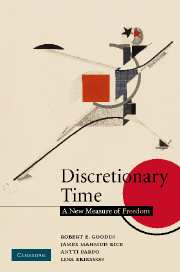Book contents
- Frontmatter
- Contents
- List of figures
- List of tables
- Preface
- Part I Introduction
- Part II Time pressure
- Part III Welfare regimes matter
- Part IV Gender regimes matter
- Part V Household regimes matter
- 13 How household regimes differ
- 14 The difference that household rules make
- 15 The difference that states make
- 16 Alternative household rules and temporal autonomy
- Part IV Conclusions
- Appendix 1 Methodology
- Appendix 2 Data
- Bibliography
- Index
13 - How household regimes differ
Published online by Cambridge University Press: 28 October 2009
- Frontmatter
- Contents
- List of figures
- List of tables
- Preface
- Part I Introduction
- Part II Time pressure
- Part III Welfare regimes matter
- Part IV Gender regimes matter
- Part V Household regimes matter
- 13 How household regimes differ
- 14 The difference that household rules make
- 15 The difference that states make
- 16 Alternative household rules and temporal autonomy
- Part IV Conclusions
- Appendix 1 Methodology
- Appendix 2 Data
- Bibliography
- Index
Summary
Choices that people make within their households can dramatically affect their temporal autonomy. We have already seen how, when two single individuals merge into a common household, each of them gains in discretionary time. We have seen that when they have children, both (but mothers more than fathers) sacrifice much autonomy over their time. We have seen that when they divorce, the partner left with the children suffers even greater losses in discretionary time.
The differences that household choices make to discretionary time can often vastly exceed any difference that governments make. To get some sense of that, let us contemplate a ‘toy example’. It is not quite right, in ways that will be discussed shortly and rectified subsequently. But it is close enough to serve the present purpose, which is merely to demonstrate how intra-household arrangements might matter for discretionary time.
Here is the example. Imagine a single, childless woman. She lives in the US at the moment, but is contemplating moving to Sweden. Judging from Figure 13.1, such a woman could on average expect to enjoy 2.5 hours more discretionary time a week if she moved to Sweden. But suppose she decided instead to stay in the US, to marry and have children, and then to divorce keeping all responsibility for the kids. Doing so would cost such a woman on average 29 hours of discretionary time.
- Type
- Chapter
- Information
- Discretionary TimeA New Measure of Freedom, pp. 199 - 223Publisher: Cambridge University PressPrint publication year: 2008



